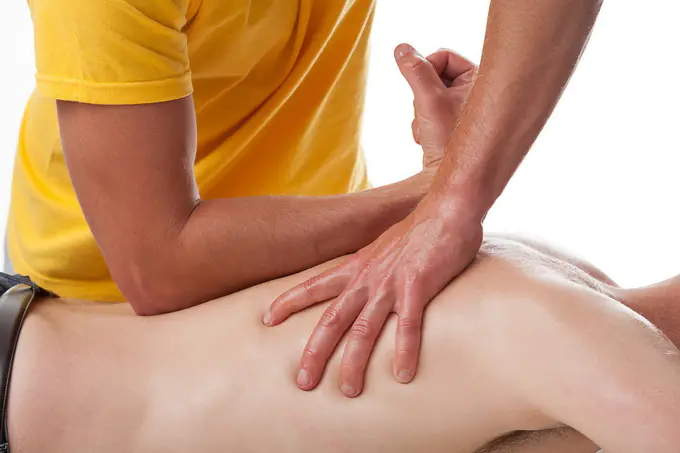Recently, oncology massage has become a valuable complementary therapy for people battling cancer. While it is important to clarify that massage does not directly treat cancer like chemotherapy or surgery, it plays a key role in relieving symptoms associated with cancer and mitigating the side effects of treatment.
Although research in this area is still relatively new, oncology massage holds promise for relieving pain, combating cancer-related fatigue, managing anxiety, and improving overall quality of life. It even meets evidence-based recommendations for relieving depression and mood disorders, especially in breast cancer patients. Additionally, massage may be the key to preventing neuropathic pain caused by chemotherapy drugs such as Taxol.

However, it is extremely important to be aware of the potential risks, including infection, bruising and skin problems. Additionally, there are circumstances in which oncology massage should be avoided, such as if there are blood clots or an extremely low platelet count. The purpose of this article is to highlight the benefits of oncology massage and how to find a qualified oncology massage therapist.
A holistic approach to treating cancer patients
Many cancer centers use an integrative approach that combines traditional cancer treatments with alternative treatments to both treat the tumor and relieve symptoms. This holistic approach is gaining momentum as it aims to improve the overall well-being of cancer patients.
Basics of Massage Therapy
At its core, massage involves gently rubbing the skin and muscles to promote well-being. While most of us are familiar with traditional back massage, massage therapy includes a wide range of techniques and styles.
Oncological massage techniques
Different types of cancer massage have unique benefits, and the best technique may vary depending on individual symptoms and the impact of cancer and its treatment on the body. Some common forms of massage include:
- Swedish massage
- Aromatherapy massage
- Classic massage
- Myofascial massage
- Anma therapy (Japanese massage)
- Deep tissue massage (recommended for chronic pain and scar tissue after treatment)

Using different methods
The effectiveness of massage largely depends on choosing the right technique to address specific symptoms. For example, gentle massage is generally well tolerated and releases endorphins, the body's natural painkillers. In contrast, conditions such as muscle tension may require more robust techniques such as Swedish massage.
Health Benefits
Oncology massage provides a range of health benefits, both physical and psychological. From a physical point of view it has been shown that:
- Reduce inflammation and swelling
- Improve blood circulation
- Relieve muscle pain
- Reduce the level of stress hormones in the blood
Emotionally, massage promotes relaxation, distracts from pain and fear, and significantly reduces anxiety and, in some cases, depression.
Is it possible to do massage if you have cancer?
Massage intuitively seems to be a benefit for people living with cancer. This provides a serene contrast to the often intense nature of cancer treatments such as chemotherapy and radiation. Moreover, cancer treatments are primarily aimed at treating tumors, making massage a specialized therapy for improving personal well-being.
Studies examining the potential benefits of oncology massage have shown promising results. For example, a 2016 study found that massage reduced pain, fatigue, nausea and anxiety in people undergoing chemotherapy.
Relieving nausea associated with chemotherapy
In some cases, oncology massage combined with other treatments has shown potential in reducing chemotherapy-induced nausea and vomiting. Research suggests that this combination therapy may be more effective than conventional treatments alone.
Managing Anxiety and Stress
Numerous studies highlight the ability of oncology massage to reduce anxiety and stress in cancer patients. What's more, it appears to reduce cortisol levels, offering additional physical benefits.
Fighting depression and mood disorders
Of all the symptoms, massage shows the strongest evidence for relieving depression and mood disorders. This is especially important because antidepressants may interact with some breast cancer medications. Research also shows that depression is associated with lower survival rates in breast cancer patients.

Fighting cancer fatigue
Massage has been found to reduce cancer-related fatigue, an unpleasant symptom that often persists long after treatment. Recent studies show that Swedish massage significantly improves cancer-related fatigue in breast cancer patients.
Pain control and management
Although massage should not replace regular pain-relieving treatments, it can help reduce pain or minimize the need for pain medications. The mechanism is not fully understood, but massage's ability to increase the release of endorphins is associated with a decrease in pain.
Preventing Neuropathic Pain Associated with Chemotherapy
Neuropathic pain, a common side effect of chemotherapy drugs such as Taxol, can be difficult to treat. A 2019 study found that classical massage given before Taxol infusion resulted in a reduction in pain, as demonstrated by nerve conduction studies.
Exploring the benefits of palliative care
In palliative care settings, massage can significantly improve well-being by distracting from the problems associated with cancer treatment.
Improving quality of life
Research on Anma Therapy, a Japanese massage technique, has shown its effectiveness in reducing physical symptoms and improving the quality of life of women with gynecological cancer.
How to make your own massage oil? We have the best recipes.
Read about kneading - the main technique in massage - in this article.
Precautions and Risks
Before you begin massaging cancer patients, it is important to consult with your oncologist, especially if you have recently had surgery, chemotherapy, or radiation therapy. Massage, like any other treatment, is associated with potential risks and contraindications.
Possible risks include:
- Infection (especially if your white blood cell count is low)
- Bruising (with low platelet count)
- Risk of fracture (for individuals with bone metastases)
- Skin breakdown (especially with deep tissue massage)
- Reactions to lotions or oils (reported allergy or sensitivity)
Contraindications:
- Blood clots
- Active infections
- Serious decrease in the number of white blood cells in the blood
- Severe thrombocytopenia
- Lymphedema (requires specialized lymphatic drainage)
- Areas of active tumor growth
- Areas around recent cuts
- Open wounds or sores
Debunking the Myth About the Spread of Cancer
There is no scientific evidence to support the idea that massage can promote the spread of cancer cells throughout the body. In fact, cancer massage is offered as a complementary therapy in many cancer treatment centers and has shown promising results in relieving a variety of cancer-related symptoms.

What to Expect During an Oncology Massage
It is extremely important to discuss any concerns or precautions with your oncologist before undergoing oncology massage. During the massage, be open with your therapist about any discomfort or need for more gentle touch. Massage sessions typically last between 30 and 90 minutes, and you can ask to stop at any time.
Where to begin
If you are unsure about how to find a cancer massage therapist, check with your medical team, as many cancer centers have specialized therapists. Alternatively, find licensed therapists with experience in oncology massage and make sure they have the necessary certification.
Exploring other alternative treatments
In addition to oncology massage, several alternative therapies can be integrated into cancer treatment to relieve symptoms and improve quality of life. These treatments include music therapy, meditation, stress management, yoga, acupressure, and acupuncture, depending on the specific symptoms you are experiencing.
Final Thoughts
In recent years, we have witnessed a paradigm shift in meeting the needs of people living with cancer. While traditional cancer treatments remain the cornerstone, complementary therapies such as massage have gained recognition for their ability to relieve pain and improve well-being. Explore your cancer center's offerings to learn how these treatments can improve your quality of life during treatment.



